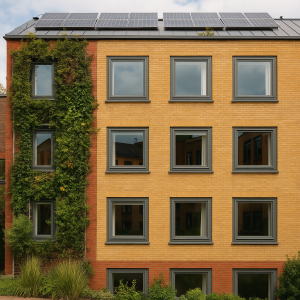 For cities seeking to meet sustainability goals and businesses aiming to reduce energy costs, commercial retrofitting presents a practical path forward. Instead of tearing down old buildings and starting fresh, HaanGlas retrofitting upgrades make them more efficient, less wasteful, and better for the environment.
For cities seeking to meet sustainability goals and businesses aiming to reduce energy costs, commercial retrofitting presents a practical path forward. Instead of tearing down old buildings and starting fresh, HaanGlas retrofitting upgrades make them more efficient, less wasteful, and better for the environment.
It’s a greener solution that avoids the environmental toll of demolition and new construction. And it’s becoming a go-to strategy for building owners who want to modernize responsibly.
Why Retrofitting Matters
Commercial buildings were built decades ago, long before energy codes or green building standards were widely adopted. These older structures often waste heat, rely on outdated lighting systems, and lack smart energy controls.
But tearing them down and rebuilding from scratch is rarely the best answer. Demolition creates mountains of debris. New construction consumes huge amounts of raw materials and energy. Retrofitting helps sidestep all of that.
By updating existing systems, retrofitting reduces emissions, saves money, and extends the life of buildings that might otherwise fall behind the times. It’s a sustainable alternative that makes economic and environmental sense.
What Retrofitting Looks Like
Retrofitting can mean different things, depending on the building and the budget. Some upgrades are small and inexpensive. Others require deeper investments. But all share a common goal: to reduce waste and increase efficiency.
Common retrofit projects include:
- Upgrading insulation and windows to reduce heating and cooling needs
- Replacing outdated HVAC systems with energy-efficient models
- Installing LED lighting and motion sensors to cut electricity use
- Integrating smart controls for lighting, temperature, and ventilation
- Improving water efficiency with low-flow fixtures and reuse systems
These improvements often work together. Better insulation means smaller HVAC systems are needed. Smart controls help avoid energy waste. Solar panels reduce reliance on the grid.
The result is a building that uses less energy, costs less to operate, and has a smaller environmental footprint.
Environmental Benefits Without the Waste
Retrofitting keeps buildings out of the landfill. That’s a big deal.
Demolishing a commercial building can produce thousands of tons of debris, including concrete, steel, glass, wood, and wiring. Most of it ends up in landfills or must be processed, which consumes even more energy and resources.
New construction is resource-intensive, too. It requires raw materials such as concrete and steel, which are among the highest-emitting industries globally. Even green new builds come with a hefty carbon cost upfront.
By comparison, retrofitting preserves the bulk of the building’s structure and shell. That means far fewer materials are needed, and much less energy is spent producing and transporting them.
A Smart Investment
Beyond environmental gains, retrofitting often makes financial sense.
Energy-efficient upgrades reduce utility bills. Innovative systems make maintenance easier and more predictable.
In some cases, building owners can also take advantage of government incentives, tax credits, or utility rebates for energy-saving upgrades. Plus, retrofitting extends the lifespan of the building. Instead of facing obsolescence or needing major repairs down the line, owners can keep their properties functional and up-to-date.
Retrofitting at Scale
In recent years, cities around the world have begun to recognize the value of large-scale retrofitting. Some have even mandated energy performance improvements for commercial buildings over a certain age or size.
Programs like New York City’s Local Law 97 or the EU’s Energy Performance of Buildings Directive are pushing property owners to take action. The goal is to reduce emissions across the existing building stock, rather than relying solely on future new construction.
These efforts reflect a broader realization: if we want to meet climate goals, we can’t just build our way to sustainability. We have to fix what we’ve already built.
Challenges to Consider
Retrofitting isn’t always simple. Older buildings may come with hidden issues, such as hazardous materials, outdated electrical systems, or code compliance problems. Some may have structural limitations that make certain upgrades harder.
Costs can also vary widely, and not every project yields immediate returns. Building owners must balance long-term savings with upfront investment and potential disruptions during renovations.
But with good planning and the right team, many of these challenges can be managed. And the benefits—lower emissions, better performance, future-proof assets—are hard to ignore.
Conclusion
Retrofitting doesn’t grab headlines like cutting-edge new construction. However, it’s one of the most effective tools we have to green our cities and reduce building emissions, without having to start from scratch.
By modernizing the buildings we already use, retrofitting helps cut waste, save energy, and lower carbon footprints. It’s a smart, scalable, and sustainable solution that respects the past while preparing for the future.
And in a world facing urgent climate challenges, that kind of practical progress is precisely what we need.